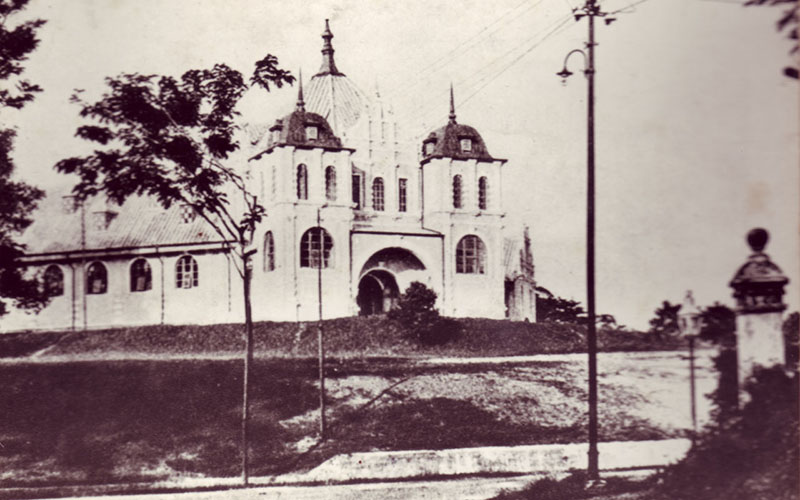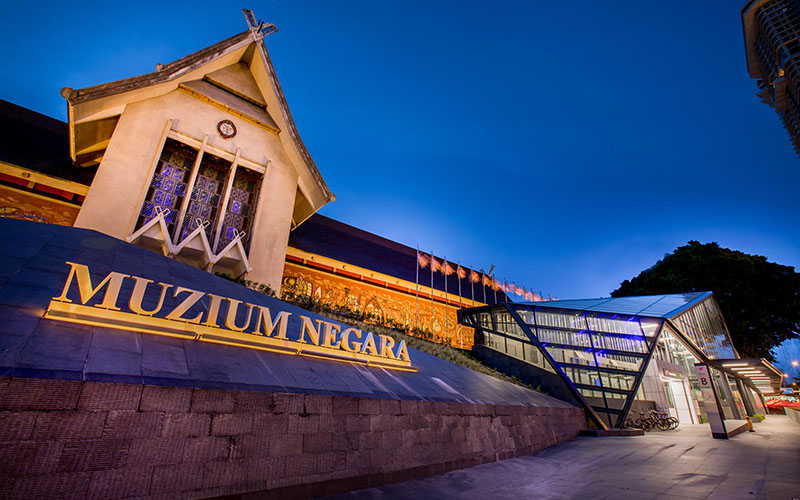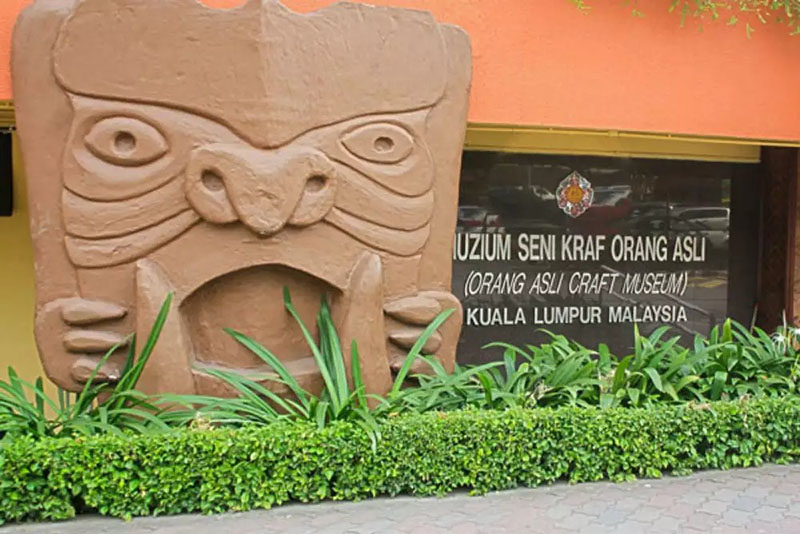The National Museum of Malaysia is located in Kuala Lumpur, the capital city of Malaysia. Its Malay name is Muzium Negara. The location is on Jalan Damansara. The museum is ideally positioned next to the Perdana Lake Gardens and provides insight into Malaysian culture and history. Its front features a fusion of contemporary and conventional Malay designs. It acts as a museum showcasing Malaysia’s significant culture and history and was established on August 31, 1963.
The National Museum is a three-story structure that is 109.7 meters (359 feet 11 inches) long, 15.1 meters (49 feet 6 inches) wide, and 37.6 meters (123 feet 4 inches) high at its center. Natural history and ethnology sections may be found in each of the museum’s four main galleries. Weaponry from the past, musical instruments, handicrafts, ceramics, flora and wildlife, and free-standing tableaux portraying weddings, festivities, and costumes are just a few of the cultural events represented in the galleries.
The History of the Museum

The National Museum was constructed at the location of the previous Selangor Museum. The Selangor and British administrations built it in 1898 after the Federated Malay States was founded in 1896. On March 10, 1945, as World War II came to an end, US B-29 bombers coming from the Coalition Forces bombed and destroyed the museum’s right wing. The Perak Museum in Taiping subsequently received the museum’s collection.
Following World War II, the Selangor Museum’s left wing continued to be used as a place of history. On the eve of the Federation of Malaya’s independence, Prime Minister Tunku Abdul Rahman came up with the concept to construct a museum that would hold priceless items from national history and culture as well as displays of animals and vegetation. The previous museum’s building was entirely destroyed to create a place for a new one.
Construction started in 1959 and was completed in 1963. The National Museum received its official inauguration on August 31, 1963, from Tuanku Syed Putra Ibni al-Marhum Syed Hassan Jamalullal, the third Yang di-Pertuan Agong. On April 4, 1996, the structure was designated as a historical landmark and ancient monument as defined by the Antiquities Act 169/1976.
The Architecture of the Museum

The museum was designed by architect Ho Kok Hoe, who drew influence from local and royal Malay buildings. The massive mosaics that adorn the entryway showcases the nation’s history and culture. The floor of the middle area of the main structure is decorated with unique tiles that were presented by the Pakistani government. UNESCO also assisted in setting up meetings with specialists in museums from other institutions all around the world.
Local arts and crafts, economic activities, flora and wildlife, weaponry, and money, as well as historical heritage, culture, and practices are included in the museum’s displays and exhibitions. There are several galleries at the museum, each featuring a different subject. On the ground floor, exhibits trace the geographical and biological development of the Malay peninsula from the Stone Age to the Bronze and Iron Ages, Hindu-Buddhist kingdoms, and the Muslim sultanate of Malacca. The historical States of Malay Hindu-Buddhists of Majapahit, Gangga Negara, and Srivijaya are mentioned.
Among the artifacts are the stone Makara statues and the bronze Bidor Avalokiteshvara. the model of the Bujang Valley Temple in Kedah, as well as artifacts from the area’s prehistoric past, including Majapahit and Javan Borobudur vessels. The exhibit covers the numerous states of Malaysia as well as the subsequent Muslim Malacca Sultanate. The exhibition emphasizes how crucial the Malaccan Sultanate was to Malaysia’s feeling of its own identity. The second level focuses on the colonial era through American Independence. Replicas of the crown-style hat worn by Malay rulers are available.
Central Hall
The Central Hall’s floor is covered in blue geometric Pakistani mosaic tiles, and its dome is paneled with elaborate carvings. To educate the public about the rich culture of the nation’s history, temporary displays are shown in the Central Hall. Occasionally, there are theme based special displays. Foreign exhibitions are also presented occasionally.
Some of the past exhibits were The Islamic Civilization, Our King, The World of Flowers, The Durian King of Fruits, Sarawak Masks, World Currency, Islamic Frontiers of China, American Frontiers, and Religious Architecture from the Netherlands.
What Else Does the Museum Ground Cover?
The Natural History Gallery and the National Sports Gallery are examples of museum galleries. Next to the museum building are a series of outdoor displays showing Malaysia’s current and historical forms of transportation. Unmatched interest may be found in the Steam Locomotive produced by Kitson & Co. in Britain, which entered service in 1921 and was out of service until 1969. On a lake that was either manmade or natural, a Tin Dredge—which resembles a floating factory—was employed to cover 1.5 million rail kilometers. At the National Museum, regular thematic exhibitions that focus on particular areas of the world’s cultures and life are also conducted.
Istana Satu
Another attraction is the Istana Satu, a historically accurate replica of a Terengganu wood palace. It was constructed in 1884 by Sultan Zainal Abidin III, the Terengganu monarch, on the grounds of Kota Istana Maziah in Kuala Terengganu. This building was built in the Terengganu Malay traditional “Rumah Tiang Dua Belas” architectural style. The utilized wood is still in good condition. Istana Satu was constructed on the National Museum grounds in April 1974. Beautiful wood carvings can be seen on the windows and doors.
The Orang Asli Crafts Museum
 Image credit: static.toiimg.com
Image credit: static.toiimg.com
The Orang Asli Craft Museum displays the creations of the indigenous Orang Asli people, who are mostly located in rural areas all throughout the Malaysian Peninsula. According to the museum, there are 18 distinct tribes of Orang Asli, including the Negrito, Senai, and Proto-Malay. Collectors highly value the wood carvings made by the Mah Meri and Jah Hut tribes, which include masks and figures.
Fees
Daily hours at the National Museum are 9:00 am to 6:00 pm. On the first day of Hari Raya Aidilfitri and the first day of Hari Raya Aidil Adha, the museum is closed. The National Museum of Malaysia entrance fee is one thing that tourists must keep in mind before going to the site. Adult residents must pay RM2 for entrance. Young people under the age of 12 are admitted free of charge. Those in school uniforms are also welcome to enter for free. The admission price for international tourists is RM5 for adults and RM2 for children between the ages of 6 and 12.
Conclusion
The National Museum of Malaysia is one of the top attractions in Malaysia. Apart from the multiple tourist attractions, this is one place that is worth a visit as the cultural and historical significance of this place is astounding. So why wait? Grab your Malaysia visa and hop on the next plane to this amazing place. Trust me this place and its attractions will blow your mind.